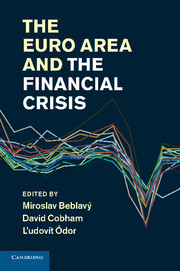Description
The Euro Area and the Financial Crisis
Coordinators: Beblavý Miroslav, Cobham David, Ódor L'udovít
This book shows how the world financial crisis has struck the euro area and examines policies to ensure its future viability.
Language: English
Subject for The Euro Area and the Financial Crisis:
The Euro Area and the Financial Crisis
Publication date: 03-2014
Support: Print on demand
Publication date: 03-2014
Support: Print on demand
The euro area and the financial crisis
Publication date: 10-2011
372 p. · 15.2x22.9 cm · Hardback
Publication date: 10-2011
372 p. · 15.2x22.9 cm · Hardback
Description
/li>Contents
/li>Biography
/li>
The financial crisis of 2007?10 has presented a number of key policy challenges for those concerned with the long-term stability of the euro area. It has shown that price stability as provided by the European Central Bank is not enough to guarantee financial stability, and exposed fault lines in governance and deficiencies in the architecture of the financial supervisory and regulatory framework. This book addresses these and other issues, including why the crisis affected some countries more than others, whether the euro is still attractive for new EU states, and what policy changes and structural reforms, both macro and micro, should be undertaken to ensure its future viability. Written by a team of leading academic and central bank economists, the book also includes chapters on the cross-country incidence of the crisis, the Irish crisis and ECB monetary policy during the crisis, and studies on Spain, the Baltics, Slovakia and Slovenia.
List of figures; List of tables; List of boxes; List of contributors; 1. Introduction Miroslav Beblavý, David Cobham and Ľudovít Ódor; 2. Towards a new architecture for financial stability in Europe Athanasios Orphanides; Part I. The Experience of the Crisis: 3. Weathering the financial storm: the importance of fundamentals and flexibility Thorvardur Tjörvi Ólafsson and Thórarinn G. Pétursson; 4. The Irish crisis Philip R. Lane; 5. The crisis in Spain: origins and developments Angel Gavilán, Pablo Hernández de Cos, Juan F. Jimeno and Juan A. Rojas; 6. The financial crisis and the Baltic countries Aurelijus Dabušinskas and Martti Randveer; Part II. Accession to the Euro Area: 7. The road to euro adoption: a comparison of Slovakia and Slovenia Biswajit Banerjee, Damjan Kozamernik and Ľudovít Ódor; 8. Is the euro really a 'teuro'? The effects of introducing the euro on prices of everyday non-tradables in Slovakia Miroslav Beblavý; 9. The euro's contribution to economic stability in Central, Eastern and Southeastern Europe: is euro adoption still attractive? Ewald Nowotny; 10. Is the euro still attractive for CEE countries? Zdeněk Tůma and David Vávra; Part III. The Future of the Euro Area: 11. Why the current account may matter in a monetary union: lessons from the financial crisis in the euro area Francesco Giavazzi and Luigi Spaventa; 12. National fiscal rules within the EU framework Daniele Franco and Stefania Zotteri; 13. The road to better resolution: from bail-out to bail-in Thomas F. Huertas; 14. Financial stability and monetary policy: lessons from the euro area Laurent Clerc and Benoît Mojon; 15. Is there a case for price level targeting? Boris Cournède and Diego Moccero; 16. Heterogeneity in the euro area and why it matters for the future of the currency union Wendy Carlin; 17. How to regain confidence in the euro area? Vítor Gaspar; 18. How to regain confidence in the euro area Stefan Gerlach; 19. How to save the euro? Lessons from the US Jacques Mélitz; Index.
Miroslav Beblavý has an unusual blend of academic and political experience. He is a Senior Research Fellow at the Brussels think tank, Centre for European Policy Studies and, at the same time, Member of the Slovak Parliament. He is also Associate Professor of Public Policy at the Comenius University in Bratislava, Slovakia. In the past, he served as a junior minister in his country's government, created an influential think tank and worked for a range of multilateral development institutions as a consultant in Europe, Africa and the Caucasus.
David Cobham is Professor of Economics at Heriot-Watt University. He is a specialist in monetary policy who has worked on UK, French and Italian monetary policy, on European monetary integration and on monetary policy and exchange rate regimes in the Middle East and North Africa. He is the editor or co-editor of a number of books on European monetary integration, including The Travails of the Eurozone (2007) and Twenty Years of Inflation Targeting: Lessons Learned and Future Prospects (Cambridge University Press, 2010).
Ľudovít Ódor is an advisor to the Prime Minister and Minister of Finance in Slovakia. In the past, he served as a member of the Bank Board at the National Bank of Slovakia and Executive Director responsible for research. He also worked as a Chief Economist at the Ministry of Finance of the Slovak Republic. He played an important role in institutional and structural reforms in Slovakia including the euro adoption in 2009.
David Cobham is Professor of Economics at Heriot-Watt University. He is a specialist in monetary policy who has worked on UK, French and Italian monetary policy, on European monetary integration and on monetary policy and exchange rate regimes in the Middle East and North Africa. He is the editor or co-editor of a number of books on European monetary integration, including The Travails of the Eurozone (2007) and Twenty Years of Inflation Targeting: Lessons Learned and Future Prospects (Cambridge University Press, 2010).
Ľudovít Ódor is an advisor to the Prime Minister and Minister of Finance in Slovakia. In the past, he served as a member of the Bank Board at the National Bank of Slovakia and Executive Director responsible for research. He also worked as a Chief Economist at the Ministry of Finance of the Slovak Republic. He played an important role in institutional and structural reforms in Slovakia including the euro adoption in 2009.
© 2024 LAVOISIER S.A.S.




